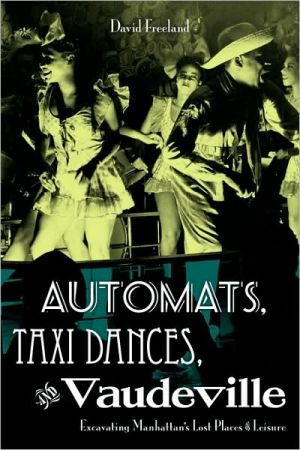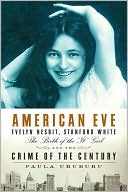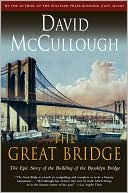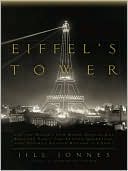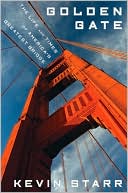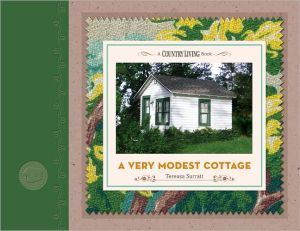Automats, Taxi Dances, And Vaudeville
Winner of the Publication Award for Popular Culture and Entertainment for 2009 from the Metropolitan Chapter of the Victorian Society in America\ Named to Pop Matters list of the Best Books of 2009 (Non-fiction)\ From the lights that never go out on Broadway to its 24-hour subway system, New York City isn't called "the city that never sleeps" for nothing. Both native New Yorkers and tourists have played hard in Gotham for centuries, lindy hopping in 1930s Harlem, voguing in 1980s Chelsea, and...
Search in google:
From the lights that never go out on Broadway to its 24-hour subway system, New York City isn't called "the city that never sleeps" for nothing. Both native New Yorkers and tourists have played hard in Gotham for centuries, lindy hopping in 1930s Harlem, voguing in 1980s Chelsea, and refueling at all-night diners and bars. The slim island at the mouth of the Hudson River is packed with places of leisure and entertainment, but Manhattan's infamously fast pace of change means that many of these beautifully constructed and incredibly ornate buildings have disappeared, and with them a rich and ribald history.Yet with David Freeland as a guide, it's possible to uncover skeletons of New York's lost monuments to its nightlife. With a keen eye for architectural detail, Freeland opens doors, climbs onto rooftops, and gazes down alleyways to reveal several of the remaining hidden gems of Manhattan's nineteenth- and twentieth-century entertainment industry. From the Atlantic Garden German beer hall in present-day Chinatown to the city's first motion picture studio-Union Square's American Mutoscope and Biograph Company-to the Lincoln Theater in Harlem, Freeland situates each building within its historical and social context, bringing to life an old New York that took its diversions seriously. Freeland reminds us that the buildings that serve as architectural guideposts to yesteryear's recreations cannot be re-created-once destroyed they are gone forever. With condominiums and big box stores spreading over city blocks like wildfires, more and more of the Big Apple's legendary houses of mirth are being lost. By excavating the city's cultural history, this delightful book unearths some of themany mysteries that lurk around the corner and lets readers see the city in a whole new light.Publishers WeeklyStarred Review. In its people and its real estate, New York maintains a complicated relationship with its past: though always moving forward, the city is also preoccupied with its grand old architecture, a refined sense of nostalgia and an idealized sense of times gone by. Still, few New Yorkers know much about the city's actual history. Historian and music journalist Freeland (Ladies of Soul) provides an excellent correction in this detailed exploration of Manhattan's lost leisure spots, from defunct 19th century Chinatown beer gardens to the earliest integrated theaters in Harlem. Along the way, Freeland unreels meticulous accounts of Manhattan's more fascinating and scandalous moments. New Yorkers past and present will learn much about parts of the city-buildings, neighborhoods, people and hot spots-long gone, or so transformed as to be unrecognizable. Focusing on five neighborhoods-Chinatown, Union Square/East Village, the Tenderloin, Harlem and Times Square-these stories provide a vivid cross-section of the city as a whole in ways a more generalized approach couldn't. Exceptionally well-written and researched, this volume will satisfy anyone curious about New York, or the way a modern metropolis builds and rebuilds itself to reflect the times. Copyright © Reed Business Information, a division of Reed Elsevier Inc. All rights reserved.
List of Illustrations ixAcknowledgments xiIntroduction xvPart I Chinatown, Chatham Square, and the Bowery 11 A Round for the Old Atlantic (The Atlantic Garden) 52 Chinatown Theater (The 1893 Chinese Theater) 25Part II Union Square and the East Village 433 A Roof with a View (American Mutoscope Studio) 474 Caretakers of Second Avenue (Hebrew Actors' Union) 65Part III The Tenderloin 795 If You Can Make 'Em Cry (Tin Pan Alley) 856 Tenderloin Winners and Losers (Shang Draper's Gambling House) 107Part IV Harlem 1297 A Theater of Our Own (The Lincoln Theater) 1358 Rise and Fall of the Original Swing Street (West 133rd Street) 155Part V Times Square 1659 The Strike Invisible (Horn & Hardart's Original New York Automat) 16910 Last Dance at the Orpheum (The Orpheum Dance Palace) 18711 Nights of Gladness (Billy Rose's Diamond Horseshoe) 203Epilogue 223A Note on Sources 231Notes 235Bibliography 251Index 257About the Author 269FiguresI.1 The former Baby Grand, 319 West 125th Street, 2008 xviii1.1 The Atlantic Garden during its vaudeville years, early 1890s 61.2 The Atlantic Garden, 2008 222.1 Interior of the Chinese Theater, 1896 242.2 Doyers Street, with the former Chinese Theater building, 2008 413.1 Filming at the American Mutoscope rooftop studio, 1897 483.2 The former American Mutoscope rooftop, 2008 624.1 Membership cards from the Hebrew Actors' Union, 1921 and 1993 644.2 The Hebrew Actors' Union, 31 East 7th Street, 2008 775.1 Tin Pan Alley during its peak years, early 1900s 845.2 View of the buildings of Tin Pan Alley, numbers 55 through 47, 2008 1046.1 Tenderloin scene, perhaps the"cork room" of Koster & Bial's, 1890s 1086.2 Shang Draper's former gambling house, 6 West 28th Street 1267.1 The Lincoln Theater, 1916 1367.2 Side view of Metropolitan African Methodist Episcopal Church, the former Lincoln Theater, 2008 1528.1 133rd Street nightclub as photographed by Andreas Feininger, 1940 1548.2 Basement level of 168 West 133rd Street, once Pod's and Jerry's Log Cabin, 2008 1629.1 Times Square Automat, 1914 1709.2 Remnant of decorative ceiling, Times Square Automat, 2006 18410.1 Orpheum dancers, 1936 18910.2 Orpheum Dance Palace, 2005 20011.1 Diamond Horseshoe patrons, early 1940s 20411.2 Diamond Horseshoe window case in front of Paramount Hotel, 2007 220E.1 Second floor of the former Nest Club building, 169 West 133rd Street, 2007 224Maps1 Bowery/Chinatown, ca. 1905 xxviii2 Union Square/Second Avenue, ca. 1928 423 Tin Pan Alley/Tenderloin, 1902 784 Harlem/West 133rd Street, ca. 1929 1285 Broadway/Times Square, ca. 1940 164
\ From Barnes & NobleTruly "the city that never sleeps," New York City has been known for two centuries for its ceaseless pace. Of course, entertainment venues are ultimately as ephemeral as they are exciting; yesterday's nightlife hot spot becomes today's abandoned building. David Freeland's Automats, Taxi Dances & Vaudeville rescues these monuments of leisure from oblivion, offering us glimpses into the once-bustling world of Gotham's German beer gardens, nickel silent movie theatres, burlesque houses, and all-night diners and bars. This carefully researched paperback will appeal to history buff fans of authors like Luc Sante and Timothy Gilfoyle.\ \ \ \ \ From the Publisher“. . .Freeland offers an area-by-area archeology of New York City's popular culture as revealed in remnants of buildings that housed leisure activities in the late-19th century to the recent past. . .A necessary resource for anyone interested in popular culture. . .”\ -CHOICE\ ,\ “Freeland combines the detective acumen of a modern Sherlock Holmes and the exploratory curiosity of Indiana Jones as he uncovers forgotten but still visible treasures of Gotham’s offbeat and seamier underside. This physical genealogy of Manhattan’s historic nightlife will become an invaluable companion for anyone exploring New York’s neighborhoods.”\ -Timothy J. Gilfoyle,author of City of Eros\ “What a treat to have Freeland take us by the hand and lead us on his own unique guided tour through a not-so-vanished Old New York! For anyone who craves a glimpse of the glamorous city of days gone by, this is a trip well worth taking. Freeland has an amazing flair for uncovering all the little pockets of history that are hiding right under our noses and even beneath our feet. I don’t think I’ll ever see the city in quite the same way again.”\ -Charles Busch,actor/playwright (The Tale of the Allergist’s Wife, Vampire Lesbians of Sodom)\ “A worthy successor to Herbert Asbury’s All Around the Town and The Gangs of New York and, more recently, Luc Sante’s Low Life, in depicting a long-vanished New York and its entertainments. . . . Many New York locales of a bygone age are depicted with panache in this incredibly well-researched volume. Freeland ‘gets it’ that behind the mostly bland facades of modern NYC lie decades of colorful history.”\ -Kevin Walsh,author of Forgotten New York\ “The richness of the New York stories he presents, in elegant prose, is more abundant than the actual brick and mortar that remain. His is a guidebook to the city’s history, to what it has bequeathed us, even as much may be lost.”\ -Library Journal\ ,\ \ \ \ Publishers WeeklyStarred Review. \ In its people and its real estate, New York maintains a complicated relationship with its past: though always moving forward, the city is also preoccupied with its grand old architecture, a refined sense of nostalgia and an idealized sense of times gone by. Still, few New Yorkers know much about the city's actual history. Historian and music journalist Freeland (Ladies of Soul) provides an excellent correction in this detailed exploration of Manhattan's lost leisure spots, from defunct 19th century Chinatown beer gardens to the earliest integrated theaters in Harlem. Along the way, Freeland unreels meticulous accounts of Manhattan's more fascinating and scandalous moments. New Yorkers past and present will learn much about parts of the city-buildings, neighborhoods, people and hot spots-long gone, or so transformed as to be unrecognizable. Focusing on five neighborhoods-Chinatown, Union Square/East Village, the Tenderloin, Harlem and Times Square-these stories provide a vivid cross-section of the city as a whole in ways a more generalized approach couldn't. Exceptionally well-written and researched, this volume will satisfy anyone curious about New York, or the way a modern metropolis builds and rebuilds itself to reflect the times.\ Copyright © Reed Business Information, a division of Reed Elsevier Inc. All rights reserved.\ \ \ \ \ \ Library JournalHistorian and music journalist Freeland (Ladies of Soul) shows us the palimpsest that is Manhattan: a volume of tales, many obscured and overwritten by newer stories, with much early material lost forever, but with parts that lurk obscurely, not entirely erased. A seeker like Freeland, who set forth both along New York's pavement and into its archival material, can discover many old stories, ripe with adventure, colorful personalities, and triumphs and sorrow. Stoked by his knowledge of local cultural and musical history, Freeland sought to "bring out of hiding" New York's obscured places, the half-visible fragments, that testify to earlier eras of the city's history of entertainment and leisure. Freeland explains that because popular culture is ever shifting and changing, and operates beyond the status quo, its built environment falls prey to destruction sooner than does that of government and finance. From Chinatown (beer gardens, Chinese theater, gang warfare) to the East Village and Union Square (the "Jewish Rialto," rooftop movie-making) to Tin Pan Alley, Times Square (the Automat, taxi dancers), and Harlem (jazz and ragtime on 133rd Street), Freeland turns his readers into intrepid time travelers. The richness of the New York stories he presents, in elegant prose, is more abundant than the actual brick and mortar that remain. His is a guidebook to the city's history, to what it has bequeathed us, even as much may be lost. VERDICT Highly recommended for all urban history buffs, New York City visitors and residents, and all studying the colorful history of urban American popular culture. [See the Behind the Book, p. 108.]—Margaret Heilbrun, Library Journal\ \
